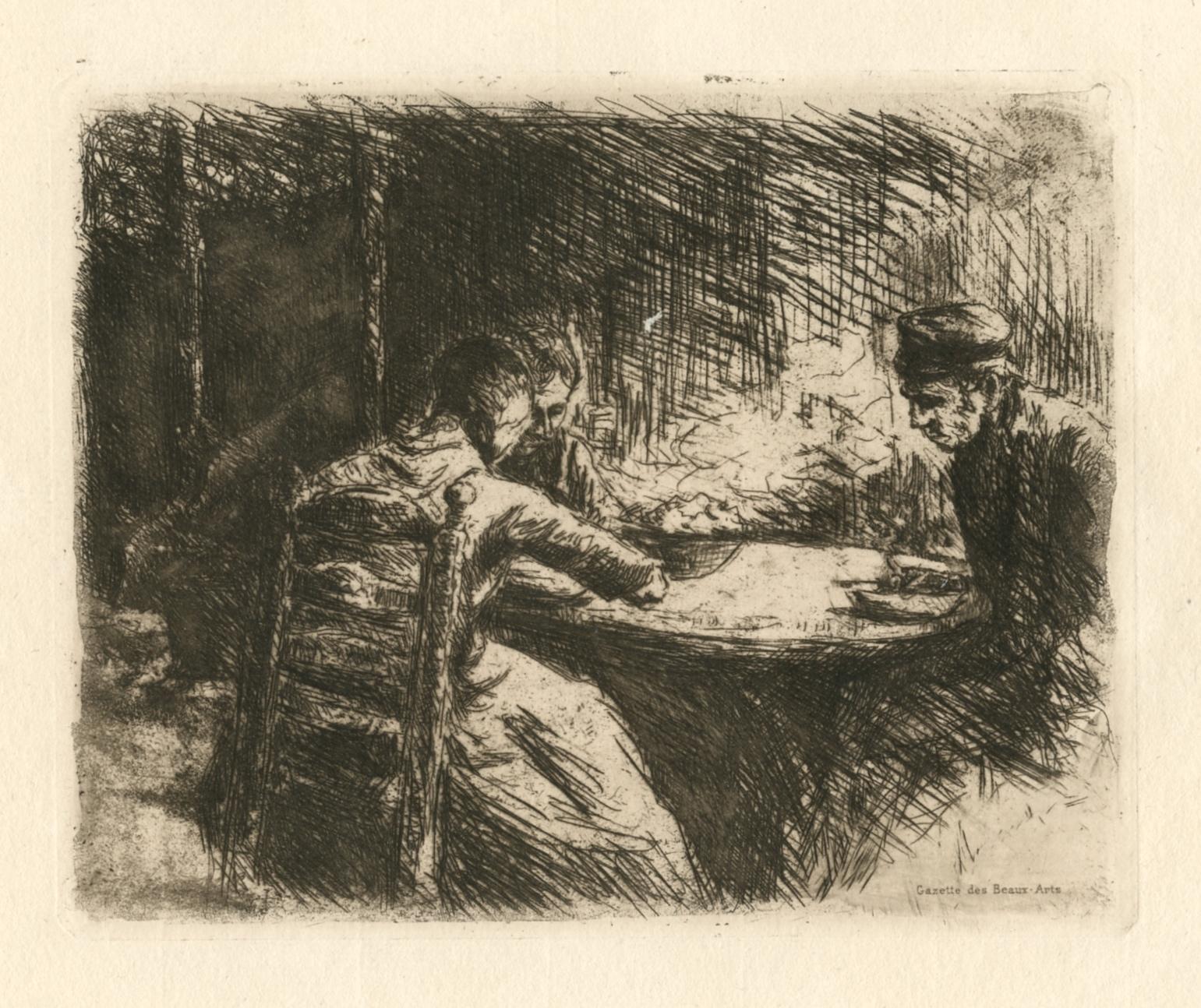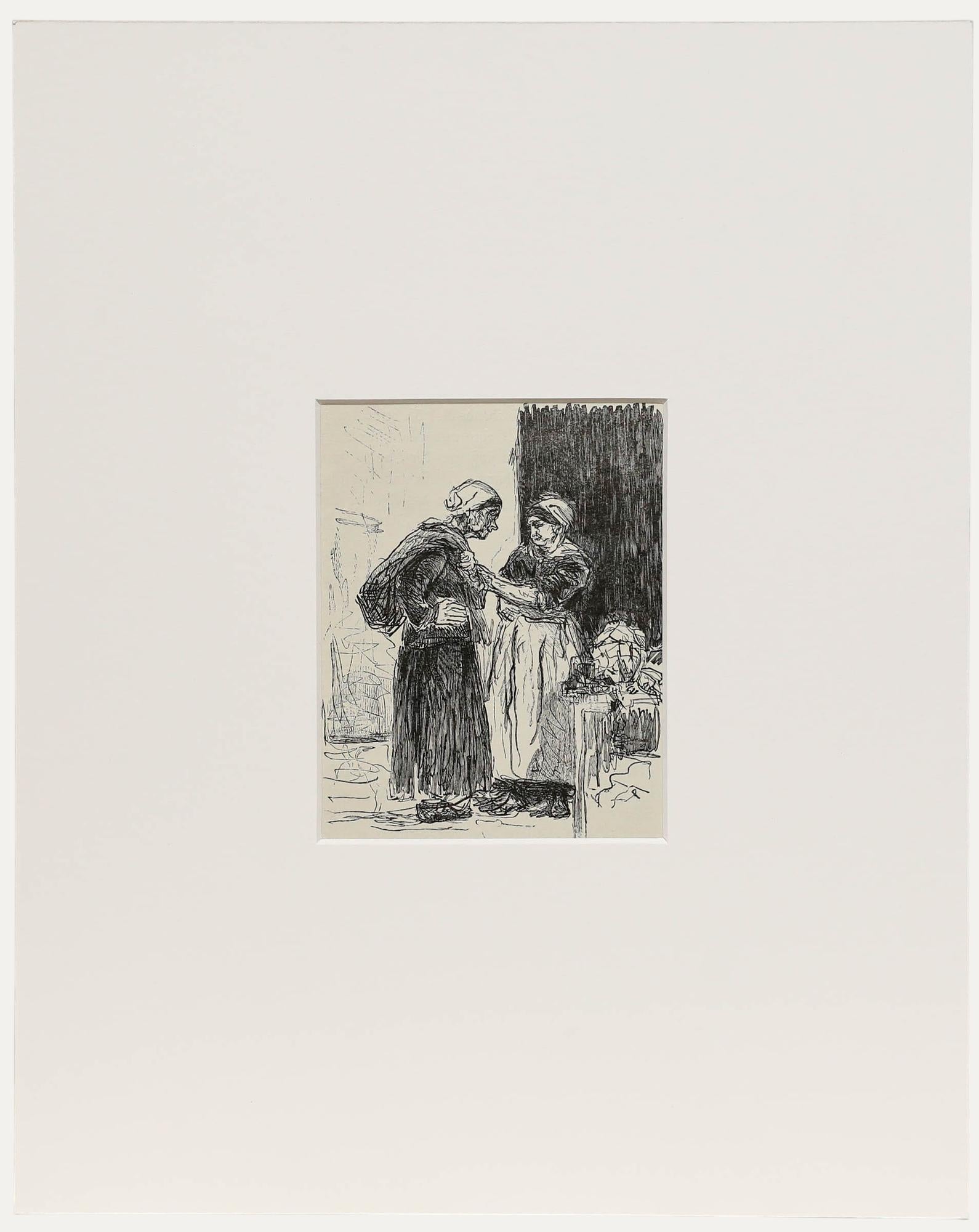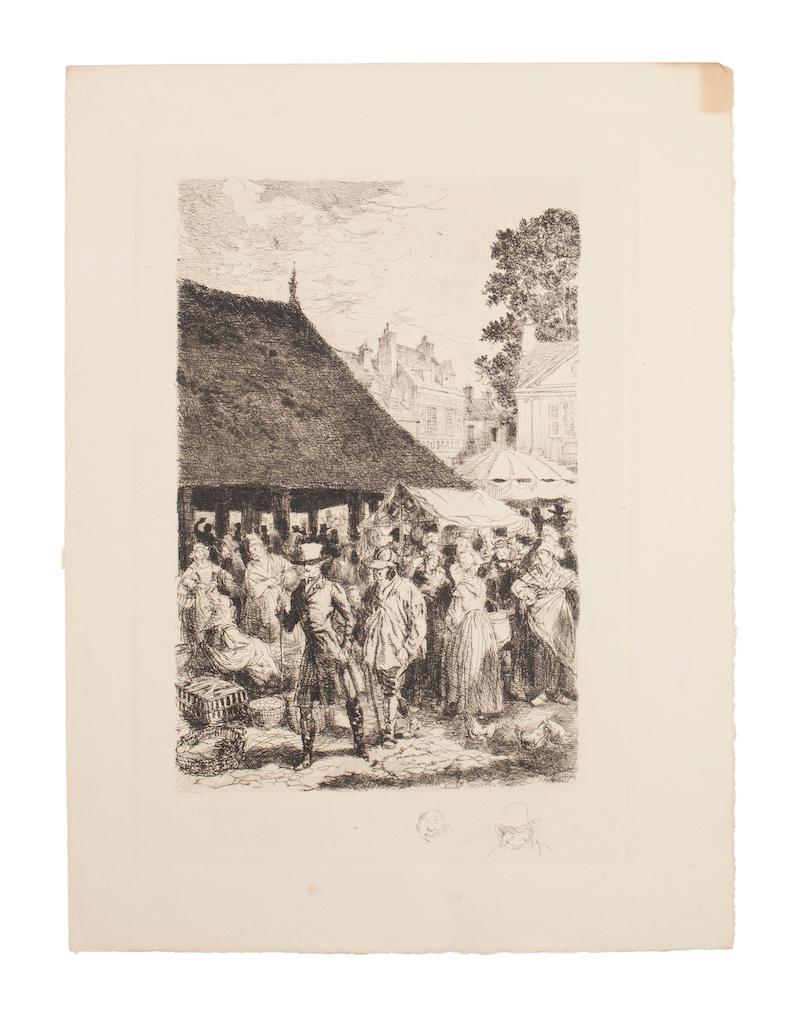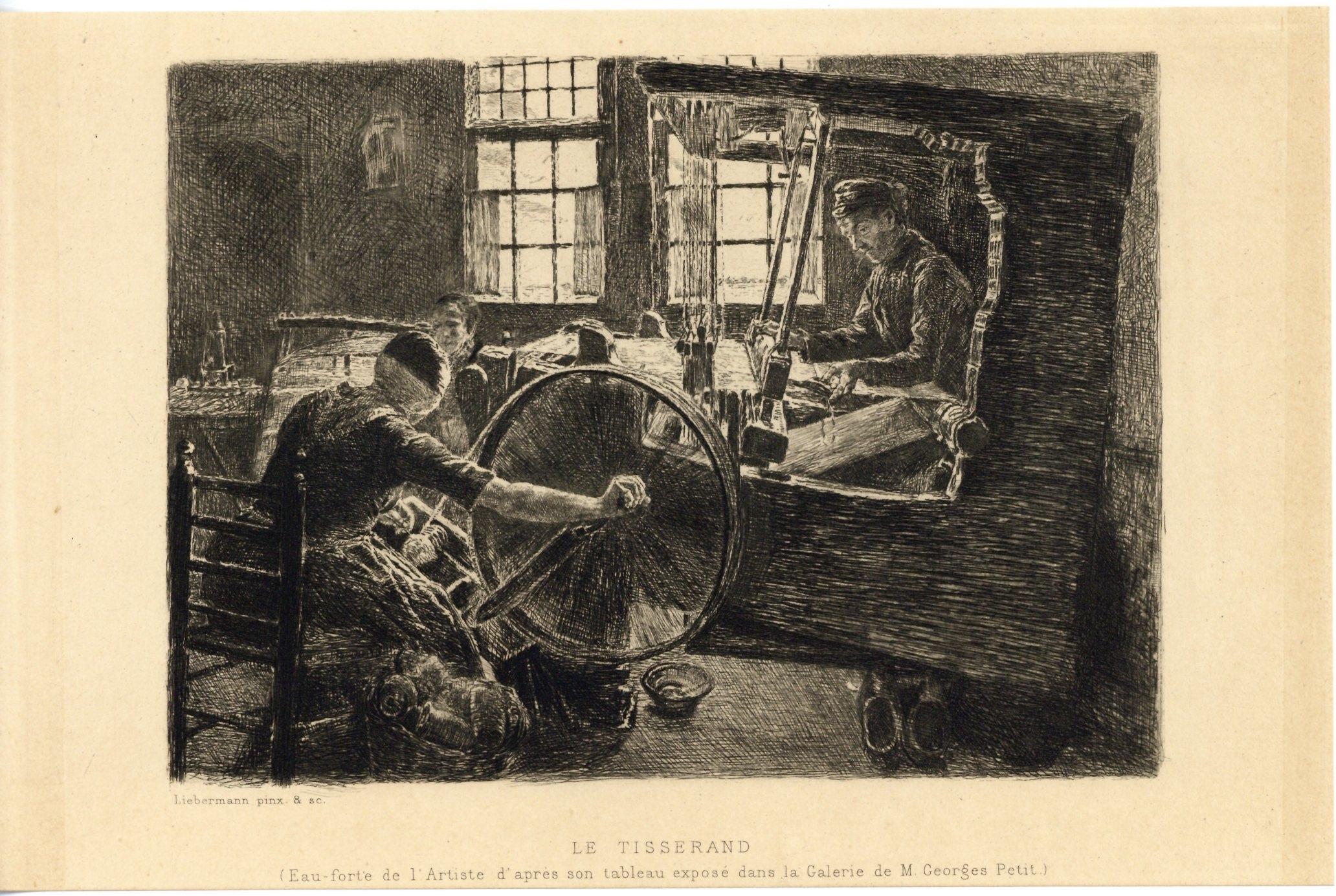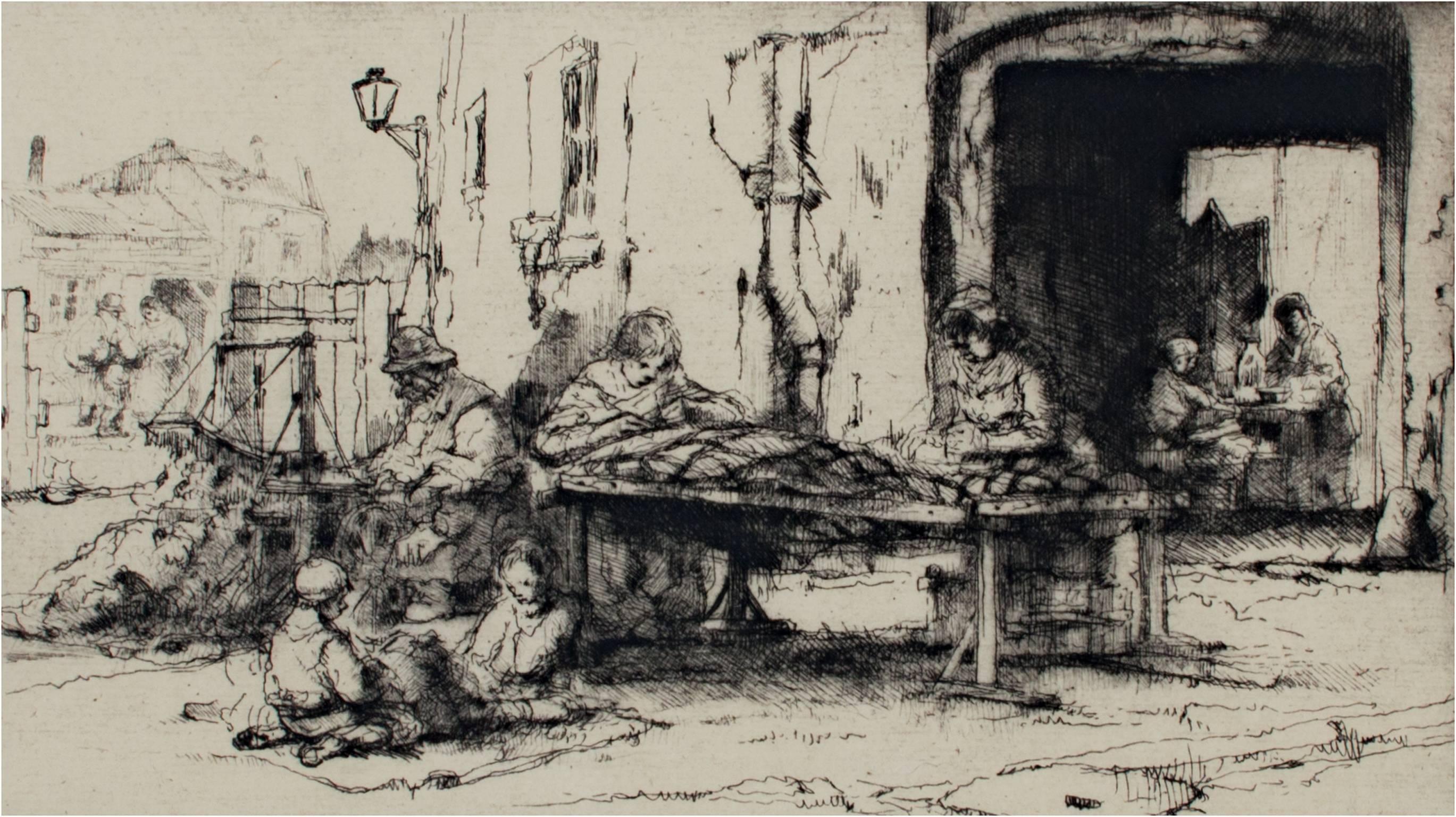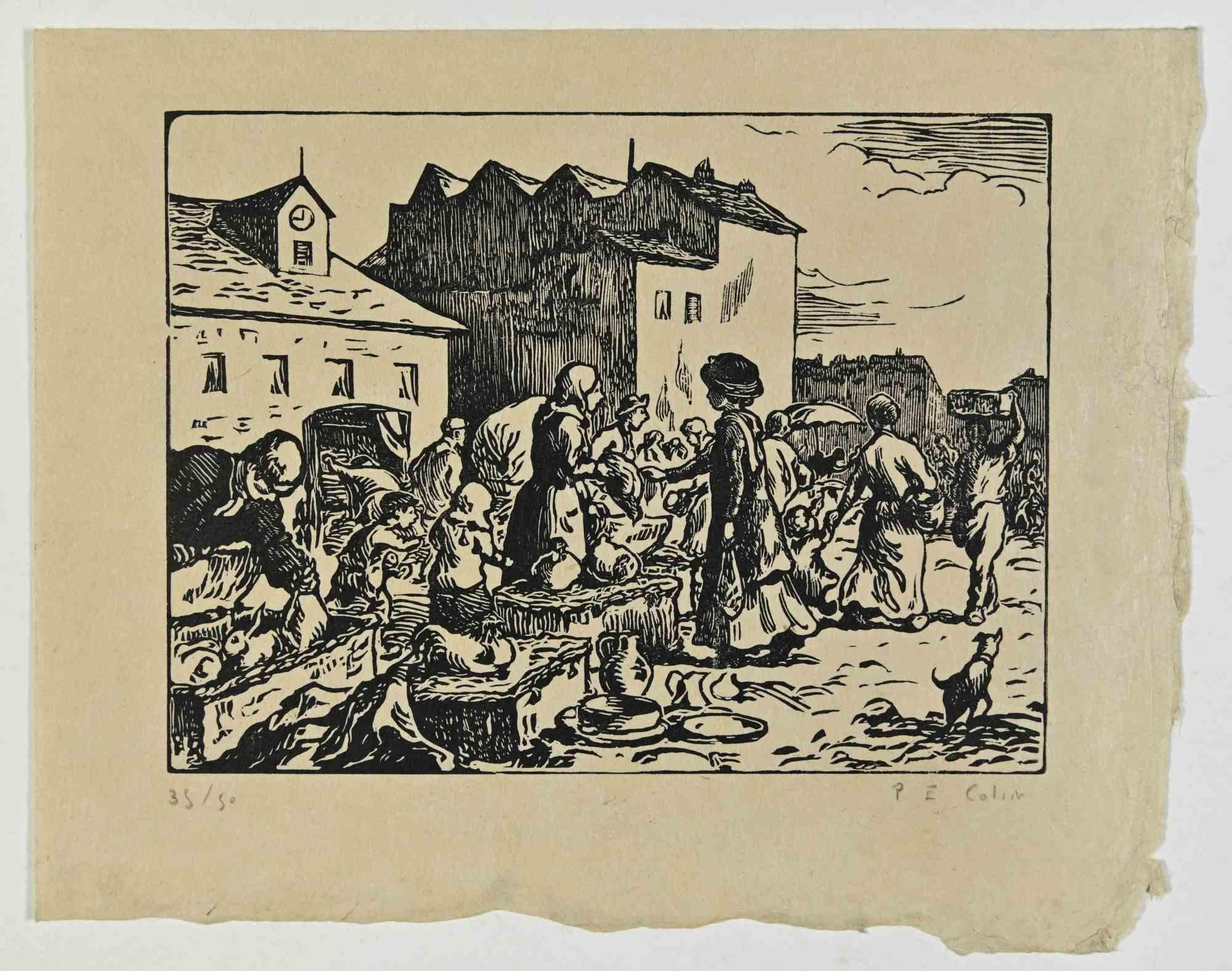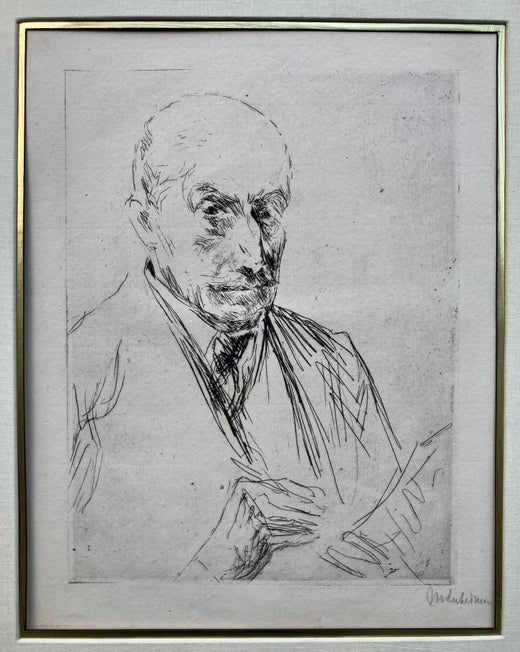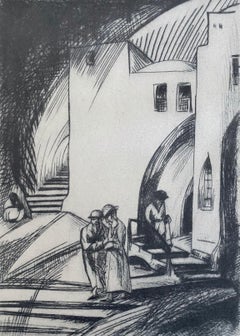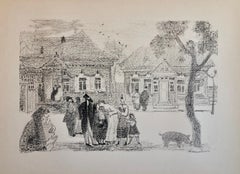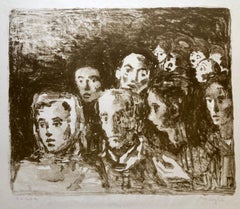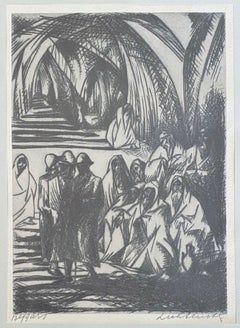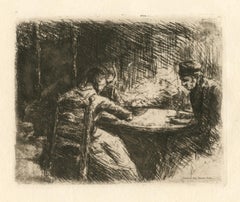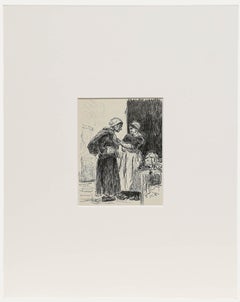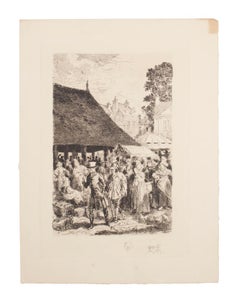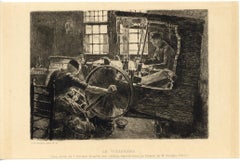Items Similar to German Impressionist Marketplace Etching
Want more images or videos?
Request additional images or videos from the seller
1 of 11
Max LiebermannGerman Impressionist Marketplace Etching1928
1928
$850
£647.06
€739.73
CA$1,195.96
A$1,308.19
CHF 688.80
MX$15,618.40
NOK 8,778.79
SEK 8,030.50
DKK 5,525.02
About the Item
Max Liebermann (20 July 1847 – 8 February 1935) was a German painter and printmaker of Ashkenazi Jewish ancestry, and one of the leading proponents of Impressionism in Germany.
The son of a Jewish fabric manufacturer turned banker[1] from Berlin, Liebermann grew up in an imposing town house alongside the Brandenburg Gate. He first studied law and philosophy at the University of Berlin, but later studied painting and drawing in Weimar in 1869, in Paris in 1872, and in the Netherlands in 1876–77. During the Franco-Prussian War (1870–71), Liebermann served as a medic with the Order of St. John near Metz. After living and working for some time in Munich, he finally returned to Berlin in 1884, where he remained for the rest of his life. He was married in 1884 to Martha Marckwald (1857–1943).
He used his own inherited wealth to assemble an impressive collection of French Impressionist works. He later chose scenes of the bourgeoisie, as well as aspects of his garden near Lake Wannsee, as motifs for his paintings. In Berlin, he became a famous painter of portraits; his work is especially close in spirit to Édouard Manet. In his work he steered away from religious subject matter, with one cautionary exception being an early painting, The 12-Year-Old Jesus in the Temple With the Scholars (1879). His painting of a Semitic-looking boy Jesus conferring with Jewish scholars sparked debate. At the International Art Show in Munich it stirred up a storm for its supposed blasphemy, with one critic describing Jesus as "the ugliest, most impertinent Jewish boy imaginable." Noted for his portraits (he did more than 200 commissioned ones over the years, including of Albert Einstein and Paul von Hindenburg), Liebermann also painted himself from time to time.
Self-Portrait, 1906, National Gallery of Art
On the occasion of his 50th birthday, Liebermann was given a solo exhibition at the Prussian Academy of Arts in Berlin, and the following year he was elected to the academy. From 1899 to 1911 he led the premier avant-garde formation in Germany, the Berlin Secession. In his various capacities as a leader in the artistic community, Liebermann spoke out often for the separation of art and politics. In the formulation of arts reporter and critic Grace Glueck he "pushed for the right of artists to do their own thing, unconcerned with politics or ideology." His interest in French Realism was offputting to conservatives, for whom such openness suggested what they thought of as Jewish cosmopolitanism. He did contribute regularly to a newspaper put out by artists during World War I.
In 1909 Liebermann bought property in Wannsee, a wealthy suburb of summer homes on the outskirts of Berlin, and designed a villa with gardens there. From the 1910s until his death, images of the gardens dominated his work. Liebermann recruited Lovis Corinth, Ernst Oppler and Max Slevogt for the Berlin Secession, together they were the most famous painters of the German Impressionism.
Beginning in 1920 he was president of the Prussian Academy of Arts. On his 80th birthday, in 1927, Liebermann was celebrated with a large exhibition, declared an honorary citizen of Berlin and hailed in a cover story in Berlin's leading illustrated magazine. But such public accolades were short lived. In 1933 he resigned when the academy decided to no longer exhibit works by Jewish artists, before he would have been forced to do so under laws restricting the rights of Jews. While watching the Nazis celebrate their victory by marching through the Brandenburg Gate, Liebermann was reported to have commented: "Ich kann gar nicht soviel fressen, wie ich kotzen möchte." ("I could not possibly eat as much as I would like to throw up.").
His work was part of the painting event in the art competition at the 1928 Summer Olympics.
Liebermann died on February 8, 1935, at his home on Berlin's Pariser Platz, near the Brandenburg Gate. According to Käthe Kollwitz, he fell asleep about 7 p.m. and was gone.
Although Liebermann had been famous, his death was not reported in the media, now controlled by the Nazis, and there were no representatives of the Prussian Academy of Arts or the city at his funeral in the Jewish Cemetery on Schönhauser Allee. However, despite official strictures by the Gestapo, more than 100 friends and relatives attended the funeral. Among the mourners were Kollwitz, Hans Purrmann, Otto Nagel, Ferdinand Sauerbruch, Bruno Cassirer, Georg Kolbe, Max J. Friedländer and Adolph Goldschmidt.
In 2005/2006, the Skirball Cultural Center in Los Angeles and the Jewish Museum in New York mounted the first major museum exhibition in the United States of Liebermann's work.
On 30 April 2006 the Max Liebermann Society opened a permanent museum in the Liebermann family's villa in the Wannsee district of Berlin. The artist's wife, Martha Liebermann, was forced to sell the villa in 1940. On 5 March 1943, at the age of 85 and bedridden from a stroke, she was notified to get ready for deportation to Theresienstadt concentration camp. Instead, she committed suicide in the family home, Haus Liebermann, hours before police arrived to take her away. There is a stolperstein for her in front of their former home by the Brandenburg Gate in Berlin.
Stolperstein of Frau Liebermann
In 2011, the Israel Museum returned a painting to the Max Liebermann estate, decades after the masterpiece was looted from a Jewish museum in Nazi Germany. Liebermann had loaned his painting to the Jewish Museum in Berlin in the 1930s. The work, along with many others, disappeared from the museum during World War II.
His painting Riders on the Beach was found as part of the Munich Art Hoard.
- Creator:Max Liebermann (1847 - 1935, German)
- Creation Year:1928
- Dimensions:Height: 7.13 in (18.12 cm)Width: 9 in (22.86 cm)
- Medium:
- Movement & Style:
- Period:
- Condition:Minor toning and small stain on upper right corner. Please see photos.
- Gallery Location:Surfside, FL
- Reference Number:1stDibs: LU38215365812
Max Liebermann
Max Liebermann (Berlin, 1847 - 1935) was a German painter, graphic artist, pastelist and illustrator. A transition from realism to impressionism is visible in his work.
In 1871 he visited the studio of the Hungarian painter Mihály Munkácsy in Düsseldorf, whose work made a great impression on Liebermann. He then makes a short trip to the Netherlands. In December 1873 he went to Paris. He met Munkácsy, Troyon, Daubigny, Corot, Millet and Manet. In the Louvre he devoted himself to the study of the Dutch masters.
In 1920 he was appointed president of the Preußische Akademie der Künste. In 1933, Hitler was elected Chancellor of Germany. Because of his Jewish background, Liebermann resigned as honorary president of the Preußische Akademie der Künste. He then joined the newly founded Kulturbund Deutscher Juden and gave financial support to young Jews who wanted to flee to Palestine. In the last years of his life, Liebermann was shunned by the German artist community.
Liebermann was active for more than sixty years and made about 1200 oil paintings. For years, Liebermann was called the "apostle of ugliness." Yet he was groundbreaking and avant-garde. The real impressionist work did not come until the end of 1900. In the Netherlands he was inspired by the wide landscapes, the sea and the beach.
About the Seller
4.9
Platinum Seller
Premium sellers with a 4.7+ rating and 24-hour response times
Established in 1995
1stDibs seller since 2014
1,846 sales on 1stDibs
Typical response time: 1 hour
- ShippingRetrieving quote...Shipping from: Surfside, FL
- Return Policy
More From This Seller
View AllBezalel School Jerusalem Israeli Judaica Etching - Street
By Isaac Lichtenstein 1
Located in Surfside, FL
YITSKHOK LIKHTENSHTEYN (ISAAC LICHTENSTEIN) (1888-1981) (Icchok, Izrael) was born in Lodz, Poland. Initially he was studying at Yehuda Pen school in Witebsk. In the same school wh...
Category
Early 20th Century Post-Impressionist Drawings and Watercolor Paintings
Materials
Etching
Vintage Russian Ukrainian Shtetl Scene Judaica Lithograph Jewish Portrait
By Anatoli Lvovich Kaplan
Located in Surfside, FL
Pencil signed and dated, Judaica Lithograph.
Anatoli Lwowitch Kaplan was a Russian painter, sculptor and printmaker, whose works often reflect his Jewish origins.
His father was a b...
Category
Mid-20th Century Modern Figurative Prints
Materials
Lithograph
Social Realist Lithograph Moses Soyer WPA Artist Hudled Refugees
By Moses Soyer
Located in Surfside, FL
Moses Soyer (December 25, 1899 – September 3, 1974) was an American social realist painter. Soyer was born in Borisoglebsk, Russian Empire, in 1899. His father was a Hebrew scholar, writer and teacher. His family emigrated to the United States in 1912. Two of Soyer's brothers, Raphael (his identical twin) and Isaac were also painters. Soyer's wife, Ida, was a dancer, and dancers are a recurring subject in his paintings. Soyer studied art in New York, first at Cooper Union and later at the Ferrer Art School, where he studied under the Ashcan painters Robert Henri and George Bellows. He had his first solo exhibition in 1926 and began teaching art the following year at the Contemporary Art School and The New School. He died in the Chelsea Hotel in New York while painting dancer and choreographer Phoebe Neville.
He was included in the show “American Modernism – Paintings from the Dr. and Mrs. Mark S. Kauffman Collection,” along with 30 leading masters of American modernism, which captured the essence of a revolutionary era...
Category
Mid-20th Century American Realist Figurative Prints
Materials
Lithograph
Bezalel School Jerusalem Israeli Judaica Etching - Beggars
By Isaac Lichtenstein 1
Located in Surfside, FL
YITSKHOK LIKHTENSHTEYN (ISAAC LICHTENSTEIN) (1888-1981) (Icchok, Izrael) was born in Lodz, Poland. Initially he was studying at Yehuda Pen school in Witebsk. In the same school wh...
Category
Early 20th Century Post-Impressionist Drawings and Watercolor Paintings
Materials
Etching
German Artist Impressionist Etching Judaica Jewish Sephardic Jewish Bezalel Era
By Hermann Struck
Located in Surfside, FL
Yemenite or Moroccan Sefardic rabbi portrait.
Framed 11 X 9 sight 6 X 4.5
Hermann Struck (6 March 1876 – 11 January 1944) was a German Jewish artist known for his etchings.
Hermann...
Category
Early 20th Century Impressionist Figurative Prints
Materials
Etching
Etching with Hand Watercolor Painting Jules Pascin Pencil Signed
By Jules Pascin
Located in Surfside, FL
Genre: German Expressionist
Subject: Figures
Medium: etching, watercolor paint
Surface: Paper
This is hand signed lower right.. there does not seem to be an edition size although th...
Category
Early 20th Century Expressionist Figurative Drawings and Watercolors
Materials
Paper, Watercolor, Etching
You May Also Like
"La soupe" original etching
By Max Liebermann
Located in Henderson, NV
Medium: original etching. This original Max Liebermann etching was published in Paris in 1901 by Gazette des Beaux-Arts (reference number Sanchez & Seydoux 1901-13). A good impre...
Category
Early 1900s Expressionist Prints and Multiples
Materials
Etching
Max Liebermann (1847-1935) - Mid 20th Century Lithograph, Vegetable Sellers
By Max Liebermann
Located in Corsham, GB
Max Liebermann (1847-1935) - Vegetable Sellers, lithograph. Printed for publication. Produced from the artist's original woodcut. Mounted. On paper.
Category
20th Century Portrait Prints
Materials
Lithograph
The Market - Original Etching by Auguste Brouet - Early 20th Century
By Auguste Brouet
Located in Roma, IT
"The Market" is an original etching on paper, realized by the French artist Auguste Brouet in the early 20th Century.
In very good condition, except for a small yellowish stain at t...
Category
Early 20th Century Modern Figurative Prints
Materials
Etching
"Le Tisserand" original etching
By Max Liebermann
Located in Henderson, NV
Medium: original etching. This impression on laid paper was published in Paris in 1898 by Gazette des Beaux Arts. Image size: 5 1/2 x 7 5/8 inches (142 x 195 mm). Not signed.
Condit...
Category
1890s Expressionist Prints and Multiples
Materials
Etching
20th century etching figurative urban scene sketch black and white signed
By Auguste Brouet
Located in Milwaukee, WI
"Les Matelassiers (The Mattress Makers)" is an original etching by Auguste Brouet. It depicts people creating a mattress outside. The artist signed the...
Category
1910s Modern Figurative Prints
Materials
Etching
Market - Etching by Paul Emile Colin - Mid-20th Century
Located in Roma, IT
Market is a Woodcut realized by Paul Emile Colin in the Mid-20th Century.
hand-signed.
Numbered.Edition, 35/50.
Good conditions with slight foxing.
The artwork is realized throug...
Category
Mid-20th Century Modern Figurative Prints
Materials
Etching
More Ways To Browse
German Etchings
Netherlands Painting Early 20th Century
Antique Marketplace
Germany Watercolor
German Impressionist
Antique Police
Antique German Etchings
Kathe Kollwitz
Antique Paintings Of Jesus
1928 Olympic
Max Slevogt
Brandenburg Gate
Hans Nagel
J Friedlander
Adolph Friedlander
Nature Watercolor Paintings
Male Nude Gray
Pencil Drawings Still Life
